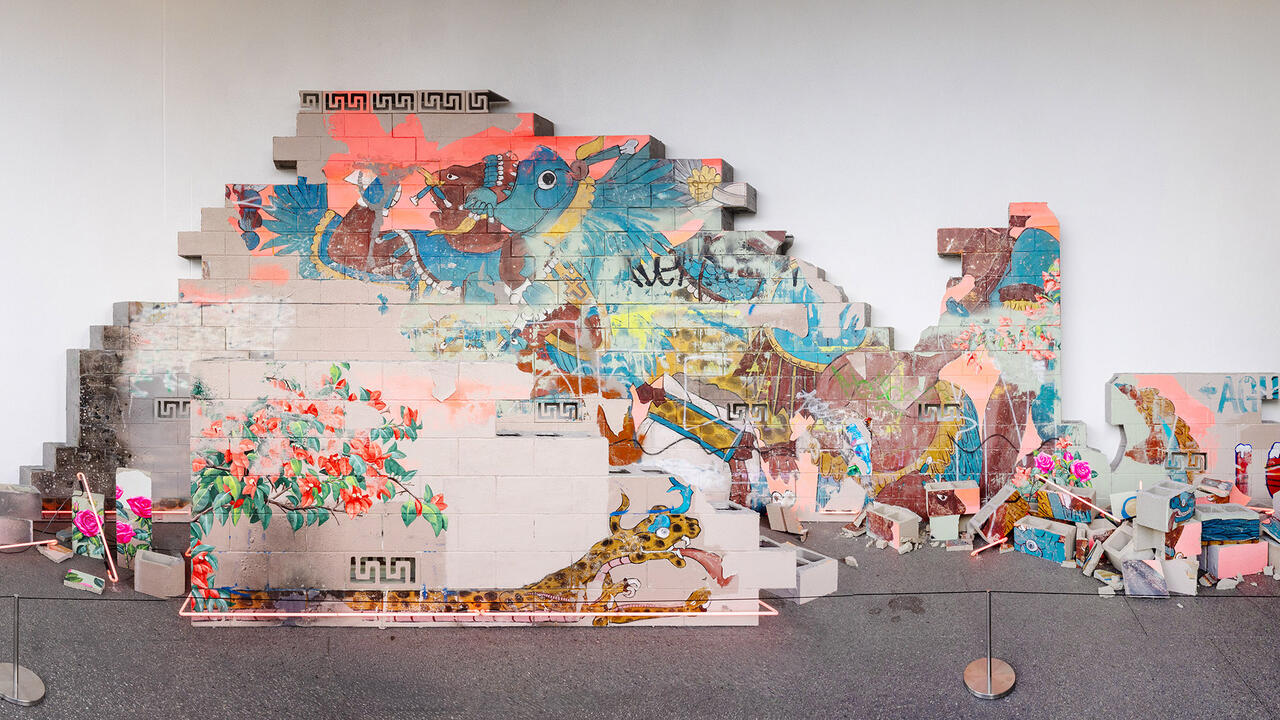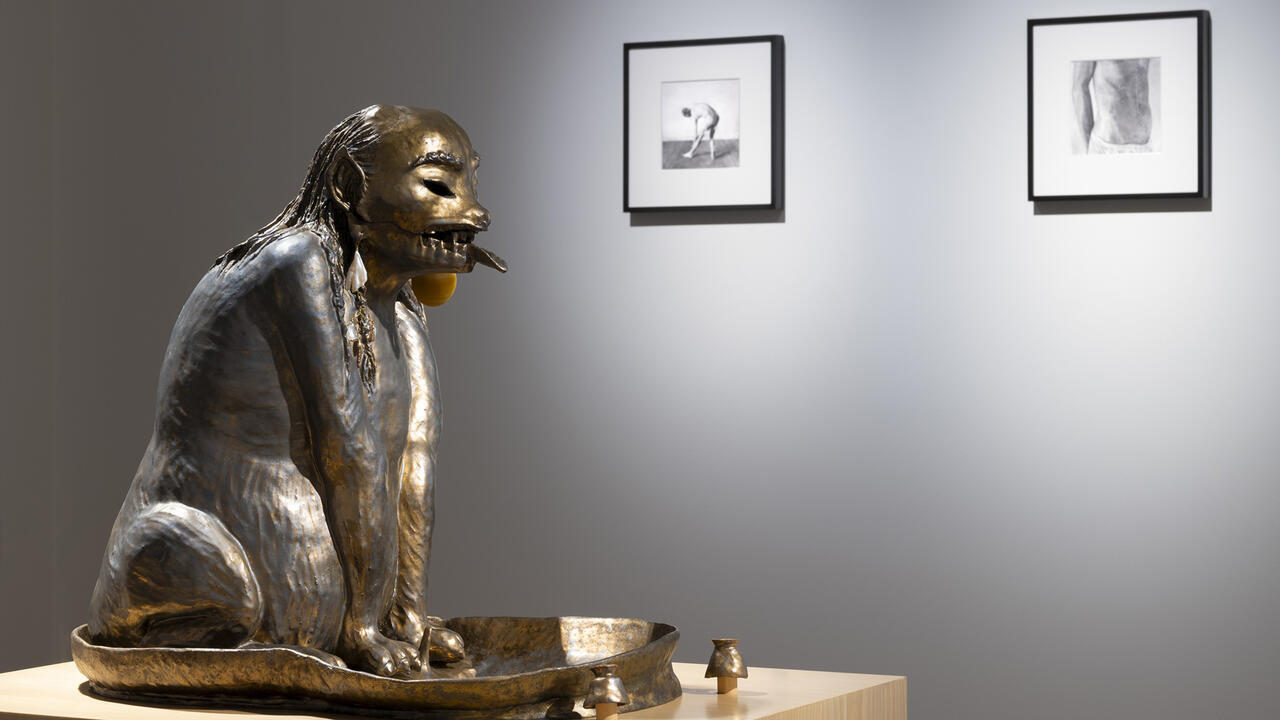‘Made in L.A. 2018’: Widely Inclusive and Brimming with Community Spirit, But Is It Too Earnest?
For the 2018 edition of the biennial, it’s as if artists feel the need to resolve situations formally where they can’t be resolved for real
For the 2018 edition of the biennial, it’s as if artists feel the need to resolve situations formally where they can’t be resolved for real

Nothing stifles criticism like righteous appeals to present problems. Admirably, the 2018 edition of ‘Made in L.A.’ – which features work by 32 artists working in the greater Los Angeles area – feels like a collective corrective for our senseless era: abundantly diverse, widely inclusive and brimming with community spirit. Rare is the piece that isn’t tuned to the general political ferment. Carolina Caycedo’s assemblages of neon fishing nets (Cosmotarrayas, 2018) hang over the Hammer Museum’s courtyard, spilling their plastic bounty, reminding us that the rivers and oceans are doomed. Aragonite Stars (2018), meanwhile – an installation by Suné Woods in an upstairs gallery – pairs stock footage of lush reefs and pool shots of costumed human swimmers. ‘We are not,’ says the voiceover, ‘the centre of the universe.’ The forests are dying, too: a series of sculptures by Charles Long resemble felled tree segments and stumps with pained faces that, on closer inspection, turn out to be cross-sectioned triple cores of spongy tissue, like chopped-up penises. (There could be an upside here, though: the patriarchy in its death throes.)

Even the most abstract paintings in the exhibition – such as Angelitos Negros (2018), an energetically striated mural by Eamon Ore-Giron, or the constraint experiments of Naotaka Hiro – incorporate cross-cultural symbolism or a politics of the body, respectively. Gelare Khoshgozaran’s haunting 16mm film Medina Wasl: Connecting Town (2018) largely depicts Fort Irwin, a training ground near 29 Palms, California built to resemble a Middle-Eastern village, paired with recitations of actual wartime stories. The symmetry is abrasive and appealing – until you consider the grid of oil drum bungs covering the opposite wall. It’s hardly news that blood is shed for oil, or that fantasy preempts reality. It’s difficult, in these days of evergreen outrage, to be stirred by artworks (or slogans, or rituals) that pin their hopes on revealing further horrors, but whose ironies make such airtight sense.
Take EJ Hill’s somber installation, Excellentia, Mollitia, Victoria (2018): the artist has decorated the Hammer’s semi-ovoid ‘vault’ gallery like a darkened outdoor track, with black paint and white stripes around a crunchy Astroturf centre, a fencelike hurdle, makeshift torch and finish line fashioned from wood and cloth. Towards the back of the curve, on top of a three-tiered winners’ podium, the artist stands motionless for some six hours a day. He is backlit by a phrase rendered in white neon: ‘where on earth, in which soils and in which conditions, will we bloom brilliantly and violently?’ Around the perimeter hang six photographs that document the artist running around the six LA-area schools he once attended. The durational performance is impactful, if you’re not expecting it; it’s a blow to open the gallery’s double doors and meet the artist, very present, staring back. Yet Hill’s many pieces soon fall into place; we deduce that the artist has declared himself victorious over the education system in a lonely ceremony staged, not without irony, in another institution. It’s an unsubtle allegory for a black, queer artist succeeding within a complex designed by white humanists. Like the artist, the piece fails to move.

With Hill’s piece and many others, earnestness isn’t the problem so much as the tidiness an earnest approach seems to encourage. It’s as if artists feel the need to resolve situations formally, where they can’t be resolved for real. True, for example, that California has been ravaged by wildfires, and so Flora Wiegmann has choreographed a five-part dance to illustrate this process of violence and renewal. (Though one may ask: renewal to what, exactly?) That forests depend on fires to reinvigorate their biome is no revelation; nor does a sequence of movements (growing and swaying like trees, then pretending to burn like them) do anything but abstract the intricacies of global warming and California weather – intricacies that, in practice, won’t be reduced to such an elegant cycle. It may feel compositionally true to formalize the uncontrollable, but to do so is factually false. Likewise, in an installation by MPA called Faultline (2018), a resin cord running along the gap between wall and floor is meant to represent a fault line, broken in places (or sutured) by little arrangements of glass and paper. A wall jutting partway into the gallery is punctured by two rectangular openings, like bank or prison windows, with chromakey green furniture on either side (Tableau, 2018). Visitors are encouraged to sit and talk through the wall – a metaphor for communicating across barriers. Work this reduced is self-obstructing; in other words, it denies what it abstracts.

The world doesn’t make sense. Why should art? Tzolk’in (2018) by Beatriz Cortez represents the Mayan calendar with a corresponding pair of gear-topped towers – one in the museum, another near the LA river – but her other sculpture on view exceeds its premise: every 20 minutes or so, a motor in Piercing Garden (2018) sends a row of steel cups of purplish and green sprouts clattering up and down on welded rods, all at different speeds and heights. No amount of explanation, no recourse to metaphor (the wall text references plant lore and the porousness of borders) can undo the work’s persistent, irreconcilable weirdness. James Benning’s contribution, Found Fragments (2016-2017), combines videos, textiles, drawings and a court document (related to a forest fire started by a car crash; chopper pilots in Vietnam; and the death of Che Guevara, among other subjects): things that don’t exactly make sense together, except under the broad rubric of America. Rational explanation here would be misleading. Nancy Lupo’s installation of found and cast benches and chairs, chocolate rabbits and a sculpture of two black swans fighting, has the inexplicable feel of a park stuck somewhere between a crummy urban space and a perverse, Disney-fied corporate playground. Lauren Halsey’s Crenshaw District Hieroglyph Project (Prototype Architecture) (2018), a mockup built with square gypsum panels for a future civic monument, formalizes recent history and black culture in the style of Egyptian tombs; among its temples, portraits and hover-boards is a litany of victims of senseless violence, some killed extra-judicially by the police. Scenes of daily life defy the grid into which they’ve been carved.

Neha Choksi’s Everything sunbright i) in the womb ii) lives iii) ever rehearsing the end * indirectly (2018), a four-channel loop, juxtaposes shots of a dancer ripping up a stage flat of a sunset, a charcoal drawing of a black-hole sun, and various orbs and emanations spinning, rhythmically but directionless, around the form of the sun’s disc. Formalism here isn’t a conclusion at all, but a kind of pivot, from which to revisit the surrounding chaos. And then there’s Linda Stark. Her square Stigmata (2011) depicts the palm of a hand, deeply whorled; a few central creases inlaid with red form a kind of intersection around the word ‘feminist’, written in burning script. The painting comprises what appear to be dozens of built-up layers of oil paint, and took some five years to complete – much longer than it takes to write a protest sign. The work does more than illustrate a crisis or declare a belief; Stark’s painting laminates humour, introspection and holiness as only time can.

Biennials are lumbering projects, and even curators who set out with no agenda may nonetheless find their selections suddenly prescient. This is not automatically a virtue. Whatever vital questions ‘Made in L.A.’ addresses, from bigotry to militarism to global warming, its success is blunted by certain works that naïvely promise us progress by offering us answers. It’s far more honest, and more realistic, to attempt to rephrase those questions altogether, as other works here do. A bad answer will stick in the present like a chronic pain; but even a bad question can open towards a more sensible future.
Main image: Lauren Helsey, ‘Made in L.A’, 2018, installation view. Courtesy: the artist



















